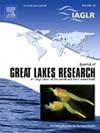Long-term dynamics of dissolved oxygen and isotopic composition in Lake Erie and Lake Ontario: Implications for eutrophication and ecosystem health
IF 2.4
3区 环境科学与生态学
Q3 ENVIRONMENTAL SCIENCES
引用次数: 0
Abstract
This study, focusing on Great Lakes Erie and Ontario, Canada, explores dissolved oxygen (DO) dynamics and its stable isotopic composition (δ18ODO) in the Great Lakes. Using historical dissolved oxygen data from 1965 to 2021, combined with synoptic isotopic data collected in the early 2000s, the research examined the spatiotemporal trends in DO and δ18O-DO to assess the effects of biotic and abiotic processes such as photosynthesis, respiration, and atmospheric gas exchange. The study revealed significant seasonal and depth-related variations in DO levels, with hypolimnetic hypoxia and metalimnetic oxygen minima (MOM) observed in both lakes. With its comparatively shallow depth and higher nutrient loads, Lake Erie exhibited more pronounced dissolved oxygen fluctuations, with DO levels reaching as low as 3.65 mg L−1 and δ18ODO values falling below +24.6 ‰. These findings indicated Lake Erie’s more dynamic metabolic environment, particularly during the thermally stratified season. In contrast, Lake Ontario showed more stable oxygen concentration levels, with occasional dissolved oxygen depletions down to 6.80 mg L−1 and δ18ODO values up to +32.1 ‰, suggesting more localised influences of external inputs and biological processes. This study provides a long-term perspective on dissolved oxygen status in these lakes and offers essential insights into their ecological health. This work contributes valuable data for managing and protecting the Great Lakes ecosystem.
求助全文
约1分钟内获得全文
求助全文
来源期刊

Journal of Great Lakes Research
生物-海洋与淡水生物学
CiteScore
5.10
自引率
13.60%
发文量
178
审稿时长
6 months
期刊介绍:
Published six times per year, the Journal of Great Lakes Research is multidisciplinary in its coverage, publishing manuscripts on a wide range of theoretical and applied topics in the natural science fields of biology, chemistry, physics, geology, as well as social sciences of the large lakes of the world and their watersheds. Large lakes generally are considered as those lakes which have a mean surface area of >500 km2 (see Herdendorf, C.E. 1982. Large lakes of the world. J. Great Lakes Res. 8:379-412, for examples), although smaller lakes may be considered, especially if they are very deep. We also welcome contributions on saline lakes and research on estuarine waters where the results have application to large lakes.
 求助内容:
求助内容: 应助结果提醒方式:
应助结果提醒方式:


